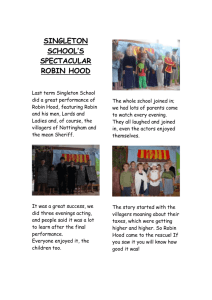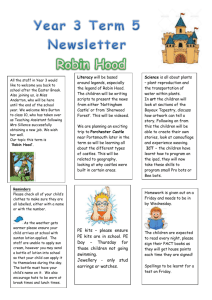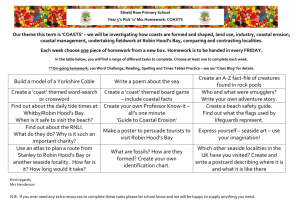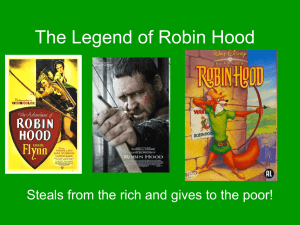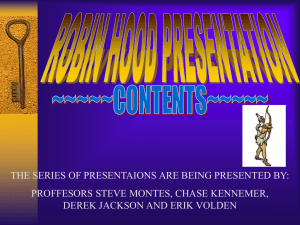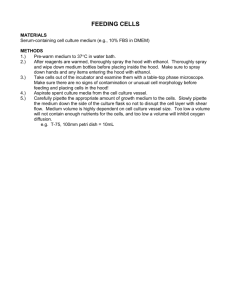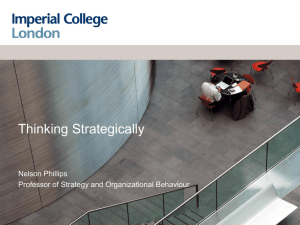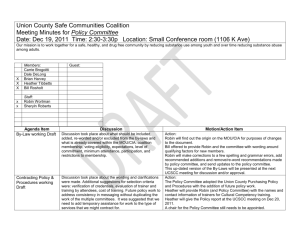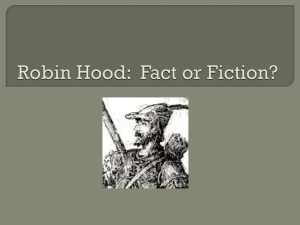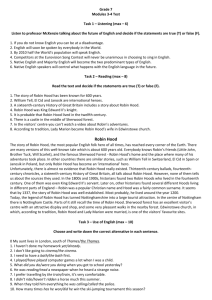ENGL 7396 Robin Hood
advertisement
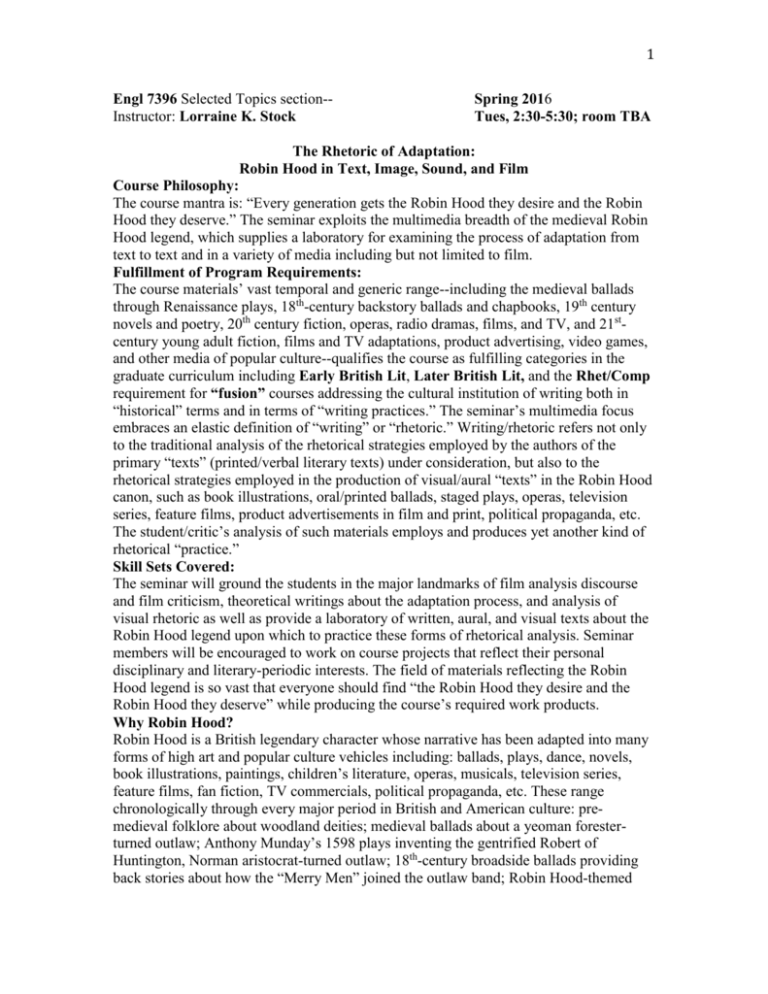
1 Engl 7396 Selected Topics section-Instructor: Lorraine K. Stock Spring 2016 Tues, 2:30-5:30; room TBA The Rhetoric of Adaptation: Robin Hood in Text, Image, Sound, and Film Course Philosophy: The course mantra is: “Every generation gets the Robin Hood they desire and the Robin Hood they deserve.” The seminar exploits the multimedia breadth of the medieval Robin Hood legend, which supplies a laboratory for examining the process of adaptation from text to text and in a variety of media including but not limited to film. Fulfillment of Program Requirements: The course materials’ vast temporal and generic range--including the medieval ballads through Renaissance plays, 18th-century backstory ballads and chapbooks, 19th century novels and poetry, 20th century fiction, operas, radio dramas, films, and TV, and 21stcentury young adult fiction, films and TV adaptations, product advertising, video games, and other media of popular culture--qualifies the course as fulfilling categories in the graduate curriculum including Early British Lit, Later British Lit, and the Rhet/Comp requirement for “fusion” courses addressing the cultural institution of writing both in “historical” terms and in terms of “writing practices.” The seminar’s multimedia focus embraces an elastic definition of “writing” or “rhetoric.” Writing/rhetoric refers not only to the traditional analysis of the rhetorical strategies employed by the authors of the primary “texts” (printed/verbal literary texts) under consideration, but also to the rhetorical strategies employed in the production of visual/aural “texts” in the Robin Hood canon, such as book illustrations, oral/printed ballads, staged plays, operas, television series, feature films, product advertisements in film and print, political propaganda, etc. The student/critic’s analysis of such materials employs and produces yet another kind of rhetorical “practice.” Skill Sets Covered: The seminar will ground the students in the major landmarks of film analysis discourse and film criticism, theoretical writings about the adaptation process, and analysis of visual rhetoric as well as provide a laboratory of written, aural, and visual texts about the Robin Hood legend upon which to practice these forms of rhetorical analysis. Seminar members will be encouraged to work on course projects that reflect their personal disciplinary and literary-periodic interests. The field of materials reflecting the Robin Hood legend is so vast that everyone should find “the Robin Hood they desire and the Robin Hood they deserve” while producing the course’s required work products. Why Robin Hood? Robin Hood is a British legendary character whose narrative has been adapted into many forms of high art and popular culture vehicles including: ballads, plays, dance, novels, book illustrations, paintings, children’s literature, operas, musicals, television series, feature films, fan fiction, TV commercials, political propaganda, etc. These range chronologically through every major period in British and American culture: premedieval folklore about woodland deities; medieval ballads about a yeoman foresterturned outlaw; Anthony Munday’s 1598 plays inventing the gentrified Robert of Huntington, Norman aristocrat-turned outlaw; 18th-century broadside ballads providing back stories about how the “Merry Men” joined the outlaw band; Robin Hood-themed 2 poems by the Romantic poets; Thomas Love Peacock’s 1822 novel Maid Marian; Alfred Lord Tennyson’s 1892 play/opera The Foresters; Howard Pyle’s 1883 American collection The Merry Adventures of Robin Hood; turn of the century American operas by Reginald De Koven--Robin Hood (1890) and Maid Marian (1901); and 20th-century popular fiction that reinvents the Robin Hood narrative for new audiences, whether in kid-lit, young adult fiction or adult-targeted erotica. In the 20th-21st centuries there was an explosion of feature films and television series too numerous to itemize, devoted to exploring the Robin Hood legend, most recently 3 seasons of the BBC TV series, Robin Hood (2006-09), and the 2010 Ridley Scott film Robin Hood, starring Russell Crowe. Robin Hood has become a protean cultural symbol that has been variously appropriated by systems of authority as well as rebels against authority. Over time, the legend has undergone reconstruction that reflected the immediate cultural needs of that period. In the political sphere, Bernie Sanders is running on the “Robin Hood” tax for the 2016 election, following the identification of Barack Obama (2008) and Mitt Romney (2012) with the British outlaw in previous election cycles. From her origins as a fertility goddess, the May Queen, to her most recent film adaptations as a gutsy warrior woman, reinterpretations of Maid Marian have mirrored the development of women’s history in the 20th-21st centuries, turning a once passive damsel-in-distress into a second wave postfeminist, proactive female partner of (and sometimes superior to) Robin Hood. Moreover, the use of cross-dressing, homosocial relations, and disguise and the emphasis on the racial/cultural divide between Normans and Saxons in Robin Hood texts invite analysis of the legend through the discourses of gender and race. A vast array of commercial products are sold by means of print and film advertising that deliberately invokes the Robin Hood “brand.” For interested students, the rhetoric of advertising can be explored for class projects. Primary Readings: 1. Robin Hood and Other Outlaw Tales, ed. Stephen Knight and Thomas Ohlgren (Kalamazoo, MI: Medieval Institute Publications, 1997), 2. Thomas Love Peacock, Maid Marian (online source) 3. Alfred Tennyson, The Foresters: both play and opera by Arthur Sullivan (online sources) 4. Howard Pyle, The Merry Adventures of Robin Hood (NY: Dover, 1968). 5. Various online-linked texts or PDF files. Secondary Readings: 1. Linda Hutcheon, A Theory of Adaptation (New York: Routledge, 2006), complete. 2. Lester Faigley et al., ed. Picturing Texts (New York: Norton, 2004), selections. 3. Michael Petracca and Madeleine Sorapure, ed. Common Culture: Reading and Writing about American Popular Culture (NJ: Pearson, 2004), selections. 4. Timothy Corrigan, A Short Guide to Writing about Film (NY: Longman, 2010), selections. 5. Various theoretical articles about film adaptation, film as spectacle, the star system, etc. placed on Blackboard. 3 Films: Selected film clips from the major films and television adaptations of the Robin Hood story are available on Blackboard; complete films are available on reserve in the library. Students may view and independently research lesser known films and TV from the instructor’s personal collection. Required Work Products: 1. A critical paper (6 pp.), due midway through the course, analyzing 2 adaptations of the Robin Hood legend (text and other media) from a chronological point of view or as cultural reflections of a particular chronological period. 2. A 1-page conference-paper abstract and a conference-length paper (10 pp.) that deals with up to 3 examples of adaptation of the Robin Hood legend, due at the end of the course. Papers will be presented at a mock conference that concludes the course. 3. Students will post reflective written weekly responses to weekly readings and media (and/or respond to their classmates’ reflections) in a blog on Blackboard. Opportunities for Professionalizing Seminar Members: 1. The conference paper and abstract are products that students can submit to the Popular Culture Association annual conference or other relevant local or national conferences about adaptation, multimedia, medievalism, etc. 2. I am creating a website, Robin Hood in Culture, to be housed at UH, under development. Student work from this course could contribute materials to the website.
